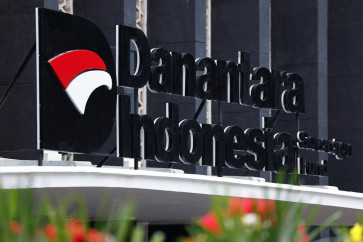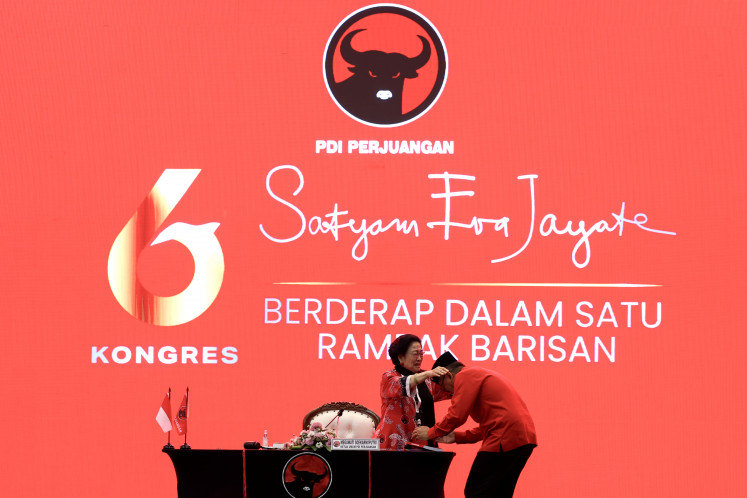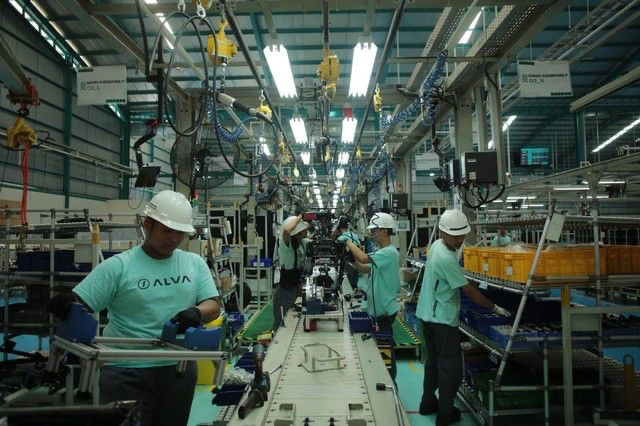Popular Reads
Top Results
Can't find what you're looking for?
View all search resultsPopular Reads
Top Results
Can't find what you're looking for?
View all search resultsPresenting the president in Yogyakarta
In the village of Kemusuk, about a 20-minute drive west from Yogyakarta, is a memorial to Soeharto, the nationâs second president and its ruler for 32 years
Change text size
Gift Premium Articles
to Anyone
I
/span>
In the village of Kemusuk, about a 20-minute drive west from Yogyakarta, is a memorial to Soeharto, the nation's second president and its ruler for 32 years.
On the way to the memorial, one passes Garuda after Garuda affixed to cement fences. Also seen on the way to the village, which is also Soeharto's birthplace, are lists touting Pancasila and statements of the values of the local kampung: tertib, sehat dan iman (order, health and piety).
The roads here are wide and clean and the houses are set back a bit. The blacktop, unlike that of the streets nearby, is smooth. There are typical views of paddy fields. In the distance, one can see the hills. It is a pleasant provincial Javanese scene.
The memorial is funded by Probosutedjo, a younger half-brother of Soeharto. Opposite it is a large car park. No doubt many visitors are expected. A house sits in one corner. Part of it is used as a barber shop. In the back, a local woman sells t-shirts adorned with Soeharto's face for Rp 45,000 (US$4.54). Her kiosk is popular.
The entrance to the memorial is broad. Visitors are greeted by a 3-meter-high statue of Soeharto in a general's uniform and carrying a baton. He cuts broad and commanding figure, although the proportions of the statue seem wrong: the legs are too short.
To the left is a musholla with glass walls and green prayer mats. A few people can be seen praying inside. To the left again is a small pond with a bronze water buffalo. Two boys are climbing over it, having fun. The experience evokes an image of Soeharto as both a rural and sophisticated Javanese, with consideration given to the military and a modest place made for Islam.
At the entrance, heavyset men sporting batik shirts and moustaches walk around, apparently not doing much, walkie-talkies hanging from their belts. Behind the entrance is a pendopo. The roof is high and the air passes through slowly.
Inside, schoolchildren watch newsreels taken from the National Archives. Gatot Nugroho, the memorial's manager and part-time guide, says the newsreels present events the perspective of the agents of history. These are the 'real' documents, Gatot says, not like Arifin C. Noer's film Pengkhianatan G30S/PKI on the aborted communist coup that was shown on television every year during the New Order era.
Around 600 people come to the museum most days, Gatot says. At peak periods, the number can climb to 800. School groups come from neighboring towns and cities. On this afternoon, many children were seen playing around the pendopo while their mothers sat and chatted. It's a pleasant atmosphere, far removed from the controversy regarding the history and legacy of Soeharto and the New Order.
To the west of the pendopo is the indoor memorial. Entering involves walking through a tunnel in which the visitor is encircled by a series of images depicting Soeharto. Visitors walk along a carpeted floor on which images of a paddy field are projected. The images, like the water-buffalo sculpture near the entrance, emphasise the general's humble origins. Soeharto's stiff body language and his scripted manner of speaking as seen in the exhibits, however, do not lend themselves to easy association with the informality and ruggedness of village life and paddy field labour.
The memorial has several digital exhibits. There is one large video screen ' some several meters wide and a couple of meters tall ' showing young men jumping and waving. The screen appears at the end of a corridor, just after the sculptures of the generals murdered during the abortive Communist coup that are curiously suspended in a plastic box.
This exhibit, the guide says, allows the visitor to participate in the protests against the Indonesian Communist Party (PKI). The rudimentary graphic representations of protestors on the screen look strangely passive. A group of eager children work their way up to the screen. A child at the back points in excitement.
At the back of the memorial's grounds is what is left of the house in which Soeharto grew up. Only its foundations remain, set against a lawn featuring small signs quoting Javanese proverbs such as 'actions need to be considered and judged' and 'self-respect is found in one's words and actions'. Gatot says that the signs are poor translation made by 'someone in Jakarta'. His
contempt is evident.
Gatot says that the Soeharto family plans to further consolidate the memory of the former president. He says that there will soon be built a Soeharto center at the Hotel Tugu in central Yogyakarta, where even more lessons on the benefits of the New Order can be expected.
Museums, however, communicate the singular messages of their curators. The family is free to romanticize Soeharto while ignoring allegations of corruption, human rights violations and worse.
Meanwhile, outside the memorial is a grand Javanese house with a front-sloping roof where the Soeharto family stays when they visit Yogyakarta.
On the porch are elaborately designed chairs and tables where women sell t-shirts emblazoned with 'Piye kabare??...iseh penak jamanku to', which can roughly be translated as 'How are things going? Is my era still wonderful?'
' Photos by Andy Fuller and Nuraini Juliastuti










